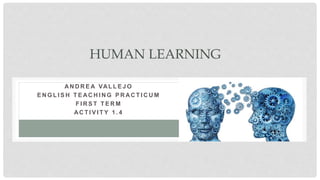
Human learning
- 1. AN D R E A VAL L E J O E N G L I S H T E AC H I N G P R AC T I C U M F I R S T T E R M AC T I V I T Y 1 . 4 HUMAN LEARNING
- 2. LEARNING AND TRAINING First, you will need to specify entry behavior Next, you need to formulate explicitly the goals of the task. You would also need to devise some methods of training. Finally, you would need some sort of evaluation procedure
- 4. PAVLOV’S CLASSICAL BEHAVIORISM The learning process consisted of the formation of associations between stimuli and reflexive responses. The human behavior should be studied objectively, rejecting mentalis tic notions of innateness and instinct.
- 5. Skinner’s operant conditioning Operant behavior is behavior in which one operates on the environment; within this model the importance of stimuli is de-emphasized Operants are classes of responses. Crying, sitting down, walking, and batting a baseball are operants Skinner was extremely methodical and empirical in his theory of learning, to the point of being preoccupied with scientific controls. Attempted to account for most of human learning and behavior.
- 6. AUSUBEL’S MEANINGFUL LEARNING THEORY The learning takes place in human organism through a meaningful process of relating new events or items to already existing cognitive concepts or propositions. It is the best understood by contrasting rote learning and meaningful learning.
- 8. ROGERS’S HUMANISTIC PSYCHOLOGY principles of behavior is the ability of human beings to adapt and to grow in the direction that enhances their existence. The goal of education is the facilitation of change and learning The learners understand themselves and communicate this self to others freely and nondefensively.
- 9. TYPES OF LEARNING IN GENERAL Signal learning. Verbal association. Principle learning Problem solving. Multiple discrimination. Stimulus- response learning Chaining Concept learning.
- 10. TYPES OF LEARNING IN SECOND LANGUAGE • the total language process • human beings make a general response of some kind to languageSignal learning • evident in the acquisition of the sound system of a foreign language • learner makes closer and closer approximations to native like pronunciationStimulus • evident in the acquisition of phonological sequences and syntactic patterns • we should not be misled into believing that verbal chains are necessarily linear. Chaining • necessary particularly in SLL • for example, a Word has to take on several meanings, or rule in the native language is reshaped to fit a SL context Multiple discriminations • the notion that language and cognition are inextricably interrelated • rules of syntax, rules of conversation- are linguistic concepts that have to be acquiredConcept learning • the extension of concepts learning to the formation of a linguistic system • rules are not isolated in role memory, but conjoined and subsumed in a total systemPrinciple learning • clearly evident in SL learning as the learner is continually faced with sets of events that are truly problems to be solved • Solutions to the problems involve the creative interaction of all eight types of learning as the learner sights and weighs previous information and knowledge in order to correctly determine the meaning of a word, the interpretation of an utterance Problem solving
- 11. TRANSFER, INTERFERENCE, AND OVERGENERALIZATION Transfer • Is a general term describing the carryover of previous performance or knowledge to subsequent learning Interference • The previously learned material interferes with subsequent material – a previous item is incorrectly transferred or incorrectly associated with an item to be learned Overgeneralization • Is a particular subset of generalization. Generalization is a crucially important and pervading strategy in human learning
- 12. One stores a number of specific instances and induces a general law or rule or conclusion that governs or subsumes the specific instances Inductive reasoning
- 13. Is a movement from a generalization to specific instances: specific subsumed facts are inferred or deduced from a general principle. Deductive reasoning
- 14. APTITUDE Number of characteristics of successful language learners Research shows some people are able to learn faster and more efficiently Risk-taking behavior, memory efficiency, intelligent guessing, ambiguity tolerance Teachers should to be optimistic, monitor styles and strategies carefully to chose appropriate ones Aptitude tests Used to predict successful language learners Modern Language Aptitude Test Pimsleur Language Aptitude Battery Was later proven that only reflected only general intelligence/ academic ability
- 15. INTELLIGENCE • It is defined and measured in terms of linguistic and logical-mathematical abilities. • There are seven types of intelligences: linguistic, logical-mathematical, spatial, musical, bodily-kinesthetic, interpersonal and intrapersonal intelligence